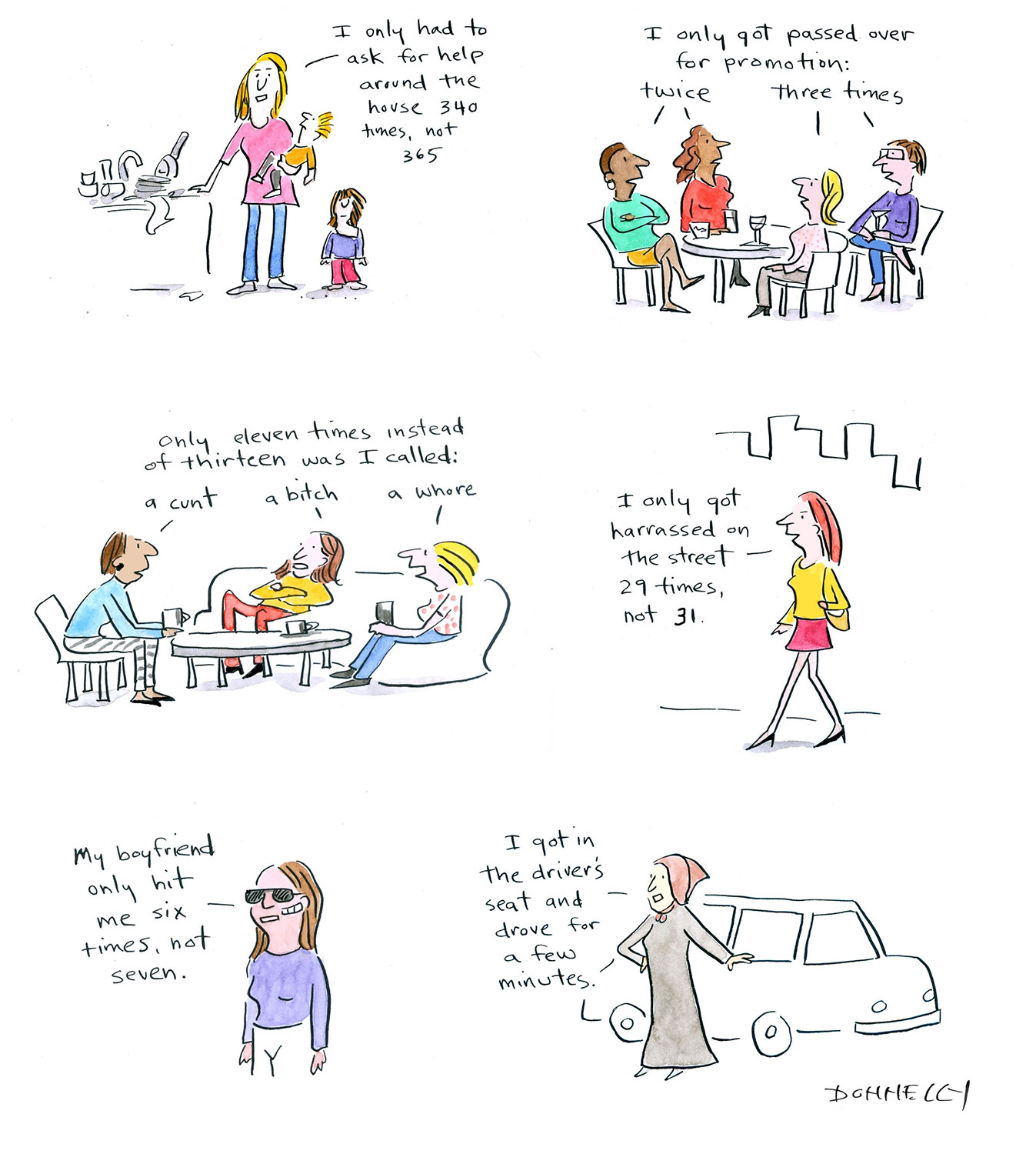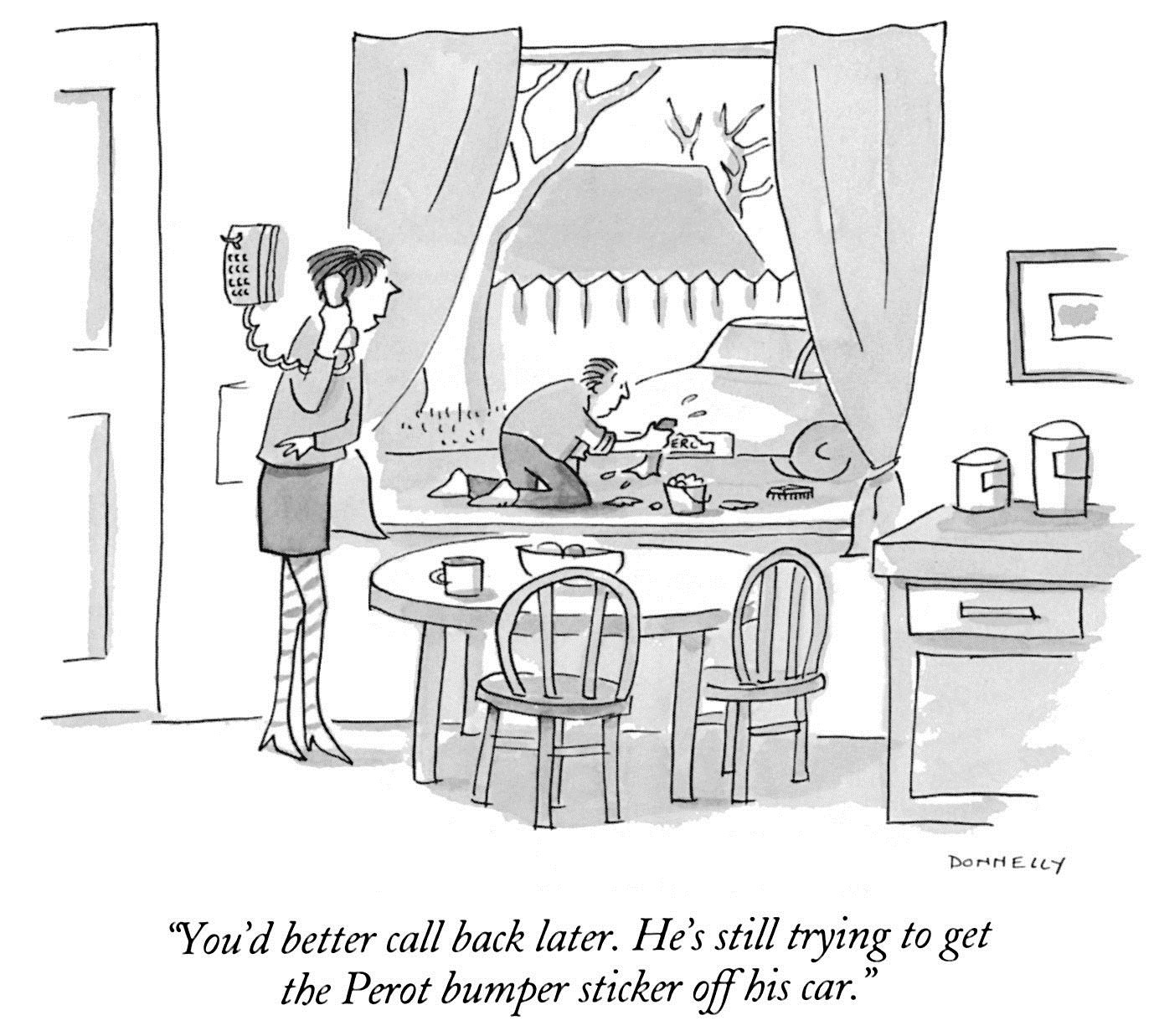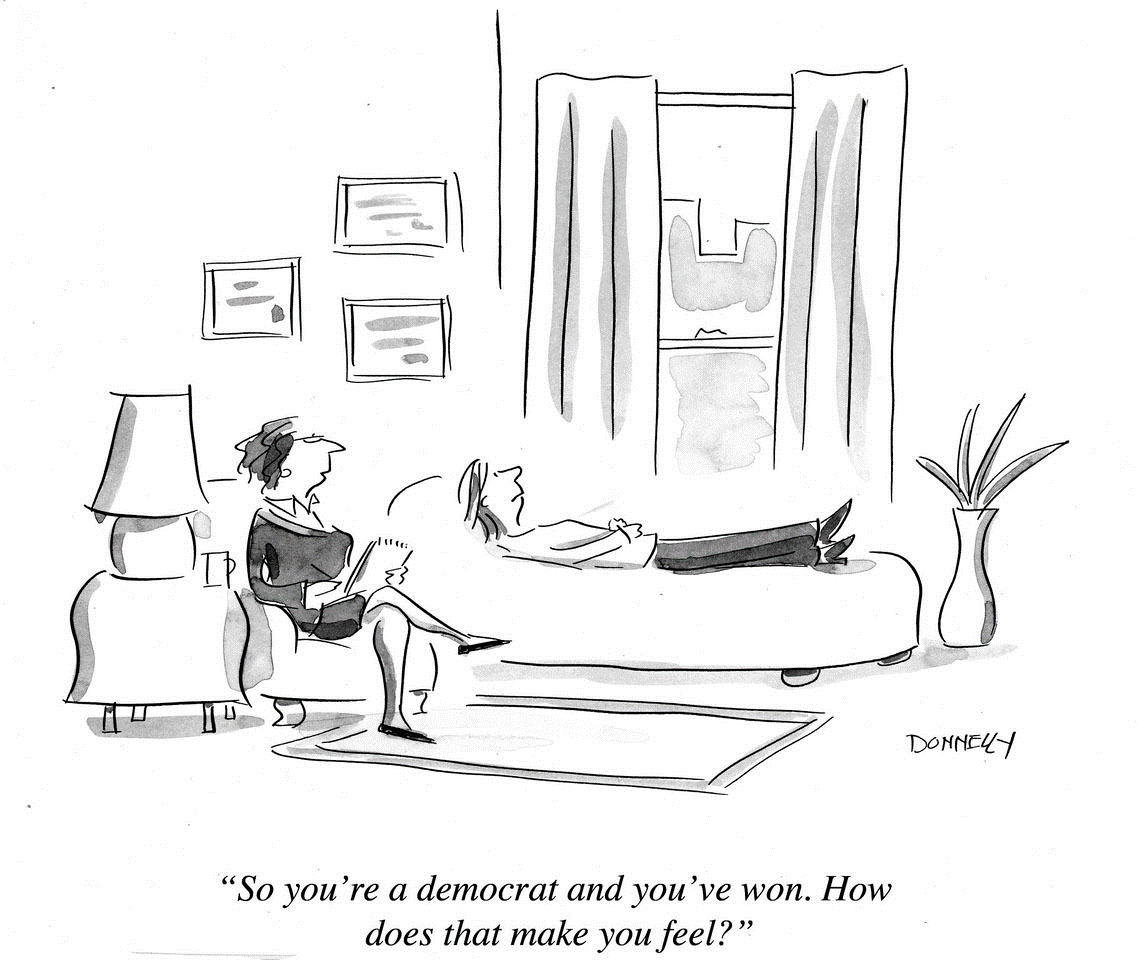Liza Donnelly: Comic Relief
About the Exhibition
Whether irreverent, ironic, or absurdly entertaining, cartoons do much more than make us laugh. Incisive by nature, these witty, intelligent reflections on the human condition invite us, with clarity and empathy, to engage with the things in life that we sometimes may rather not confront.
For Liza Donnelly, hand-drawn lines are a means of launching political movements or calling leaders into account, of questioning the way we live our lives and finding common ground. “I don’t really think a cartoon can change someone’s mind,” she says, “but it can start a dialogue.” An accomplished cartoonist, writer, and visual journalist, Donnelly believes that humor can open the door to new ways of seeing, connecting us in ways that words alone cannot.
Donnelly’s incisive and delightful cartoons and visual essays are inspired by the world around her. They have been featured in The New Yorker, where she has been a contributing artist and writer since 1979, and in The New York Times, Ms. Magazine, CBS News, NBC, CNN, Forbes, Fusion, Medium, Narrative, Politico, The Daily Beast, Salon, The Huffington Post, and Glamour, among others. She is the creator of live digital drawing and she has spoken internationally and at the United Nations on behalf of Cartooning for Peace.
This exhibition explores the organic evolution of Donnelly’s desire to express herself and to engage with the world through drawing, tracing her transformation from a painfully shy child growing up in Washington, D.C. to her emergence as a New Yorker artist and activist. The artist’s humorous, buoyant drawings provide much- needed comic relief in uncertain times, and we are honored to celebrate her exceptional and memorable accomplishments.
About the Artist
Liza Donnelly begins her day by checking major news outlets like CBS, CNN, NPR, and Twitter, creating and sharing digital drawings inspired by the day’s most pressing issues as they unfold in real time. Whether working remotely or on location, her images convey a sense of candor and authenticity, documenting the Oscar and Tony Awards and New York Fashion Week, the Democratic National Convention and Presidential Debates, women’s rights, or life’s small but notable moments. The artist’s live digital reporting and cartoons have been featured in The New Yorker, where she has been a staff artist since 1979; on CBS News, NBC, and CNN; and in Forbes, Fusion, Medium, Narrative, Politico, The Daily Beast, Open Salon, The Huffington Post, and Women’s eNews, among others. She is the creator and editor of World Ink, which connects the work of cartoonists around the world, and she has spoken internationally and at the United Nations on behalf of Cartooning for Peace, an organization that defends fundamental freedoms and democracy as inspired by article 19 of the Universal Declaration of Human Rights: “Everyone has the right to freedom of opinion and expression; this right includes freedom to hold opinions without interference and to seek, receive and impart information and ideas through any media and regardless of frontiers.” Her column and drawings on politics and global women’s rights appear regularly in Medium.
A self-described feminist, Donnelly is the author of Funny Ladies: The New Yorker’s Greatest Women Cartoonists and Their Cartoons, which chronicles the history of women and cartoons in the venerable publication; Sex & Sensibility, which offers female perspectives on love; Women On Men, a 2014 finalist for the Thurber Prize for American humor, and many other humor books for adults. Dinosaur Day, Dinosaur Beach, and Dinosaur Valentine are among her children’s picture books.
Images
The Artist as a Young Cartoonist
As a quiet child who loved to draw, Liza Donnelly found that cartoons helped her to communicate and to share her observations of the world with family and friends. Art helped her to express herself, and more importantly, it made her mother laugh. Her father, a physician, was often working, and her sister was a rebellious child. “I thought it was my job as the younger, quieter daughter to make my mother happy.” A book of cartoons by American illustrator James Thurber—a gift from her mother—offered a glimpse into the possibility that being a cartoonist might be possible. “I became the artist in school, drawing my friends, drawing people, and that’s where my love of cartooning started.”
All for Love
Love, marriage, divorce, sex, and parenting have been ongoing themes in Liza Donnelly’s art, perhaps with good reason. She has been married to veteran New Yorker cartoonist Michael Maslin for more than thirty years, and their cartoons reveal the humor and pathos in relationships from both a male and female perspective. The challenges of co-habitation, communication, and child-rearing invite Donnelly’s hilarious perspectives on the way that relationships work, or sometimes fall down on the job. Cartoon Marriage, a 2009 book that Donnelly and Maslin collaborated on, is a comedic inside look at the life’s small moments and the complications inherent in loving relationships. “We weren’t sure if it would damage our marriage,” she said, “but it probably brought us closer together because we had a lot of cartoons about marriage to start with.”
Womanpower
When Liza Donnelly was in college, the second wave of feminism was in full swing, and though she championed equal rights for women from the start, “I didn’t think I was a feminist cartoonist—I just wanted to be a cartoonist.” But while working at The New Yorker, she realized that there were very few women drawing cartoons, and that female artists could offer unique and meaningful perspectives. Tina Brown, editor of The New Yorker from 1992 to 1998, especially appreciated Donnelly’s work and published “a lot of it.” This helped to foster Donnelly’s humorous voice as a woman and inspired her to view cartooning as a means of bringing sexism and other feminist concerns to light. The subject of equality and women’s rights at work, at home, in society, and around the globe remains a significant theme in her work today. Her books Funny Ladies: The New Yorker’s Greatest Cartoonists and Their Cartoons (2005) and Sex and Sensibility (2008) highlight the contributions of noted and lesser-known female visual humorists.
Political Observer
As she grew as an artist and visual commentator, Liza Donnelly shifted her focus to matters of national and global importance. Right after 9/11, she “spoke out more” and dedicated herself to circulating cartoons focused on the political landscape for the pages of The New Yorker and other outlets, both print and digital. “There were things in the news that inspired me, such as Hillary Clinton’s 2008 run for president,” she said. Though she has a particular political viewpoint, she avoids strident negativity and “tries not to be that loud, because you can get more of a conversation going that way.” Still, Donnelly feels that it is important for political cartoonists to scrutinize elected officials and to hold them accountable, an artistic tradition that is centuries-old.
Cartooning for Peace
Cartooning for Peace was launched after the 2005 Jullands-Posten Muhammad cartoon controversy, which was sparked after twelve editorial cartoons depicting Muhammad, a principal figure of Islam, were published in the Danish newspaper. Islam has a strong tradition of aniconism, the absence of material representations of the natural or spiritual world. Muslim people were deeply offended by the drawings, and their widespread internet distribution led to violent protests around the world. In questioning the editorial cartoonist’s role, French artist Jean Plantu imagined Cartooning for Peace and brought it to the attention of United Nations Secretary-General Kofi Annan. On October 16, 2006, Unlearning Intolerance—Drawing Peace, a seminar organized by Plantu and Annan, was held at the UN, and Donnelly was one of twelve international cartoonists invited to participate. A fan of the medium, Annan said, “I have always thought that cartoons are one of the most important elements in the press. They have a special role in forming public opinion—because an image generally has a stronger, more direct impact on the brain than a sentence does, and because many more people will look at a cartoon than read an article.” Today, more than one-hundred-fifty artist are members of Cartooning for Peace. “We use our craft to talk about global issues and how cartoons can be used to inspire dialogue and understanding—how they can be used for good,” said Donnelly, who helps to jury the organization’s global cartooning awards, which are presented every other year.
Surviving COVID-19
Liza Donnelly lives in New York State and has closely observed the impact of COVID-19 on the lives and psyches of the American people. Her cartoons on the subject have been both poignant and funny, tracing the lives of everyday citizens who are trying in their own way to cope with a challenging situation. “This is what cartoonists do, we comment upon what’s going on in life, and so the pandemic is life now,” she observed. “I’ve had to draw a lot of people wearing masks.”
Our Lives and Times
When working on single panel cartoons for The New Yorker and other publications, Liza Donnelly is a theatrical director who acts as the “script writer, casting director, set designer, and choreographer.” Though the narratives that unfold in her art are inspired by real life, artistic license is an essential aspect of making things work. Captions sometimes come first, but more often than not, Donnelly finds that cartoon images and words evolve simultaneously—a craft that is learned over time. “My cartoons are not laugh-out-loud, necessarily, they are slices of life, observations about what’s going on and the things that people say to each other. Those things can be funny,” Donnelly said. “So it’s a sharing, it’s about experiencing life together and not always about a joke.”
The Art of the Picturebook
In the 1980s as Liza Donnelly was building her career as a cartoonist, “people kept suggesting that I try children’s books, but I couldn’t much focus on it.” She did, however, create a mockup of a book concept inspired by the monsters she drew as a child, but editors at Scholastic asked if she might turn her imaginary creatures into dinosaurs. In 1987, Dinosaur Day launched a series of seven books about a little boy and his dog with a fascination for prehistoric animals and a love of adventure. She found children’s books to be an enjoyable respite from the news and world’s realities, which more directly inspire her cartoons. Bright and colorful, Donnelly’s books have minimal text, with narratives that are propelled forward by the fun-filled experiences of her endearing characters. Dinosaur Halloween, Dinosaur Thanksgiving, Dinosaur Beach, The End of the Rainbow, and A Hippo in Our Yard are among her many books for young readers.
Live Drawing
Liza Donnelly is passionate about live digital drawing, which allows her to capture and share the immediacy of any moment, whether on location or in the comfort of her living room. About five years ago, she received a gift of an iPad and explored its possibilities. “I was watching a State of the Union address on television and began drawing, sending out each sketch on Twitter.” Public response was enthusiastic and positive, “and the drawings were loose, bold, and colorful—impressions of the people in the room and the president himself.” Digital drawing soon became a way for Donnelly to converse with people through social media, and the art form has become an important and enjoyable aspect of her career. CBS and CNN have hired Donnelly as a visual correspondent at the Oscar, Grammy, and Tony awards, and she has also covered the Democratic National Convention and the Women’s March on Washington. Each evening at 5p.m. on Instagram, she draws and narrates her impressions of the events of the day. “It’s so fluid,” she said. “I love the feel of a crowquill pen on paper, but I like the immediacy of digital drawing and love sharing it with people.”
Liza Donnelly: Live Drawing Gallery
Published: July 2020
Media
Exhibition Video – Liza Donnelly: Comic Relief
Published: July 2020
Exhibition Preview – Liza Donnelly: Comic Relief
Published: July 2020
NOTE: We apologize in advance for the audio issues with Liza Donnelly’s microphone.
Cartoon Marriage: A Conversation with Liza Donnelly & Michael Maslin
Published: August 2020
Finding Funny in a Screwed Up World: A Conversation with New Yorker Cartoonists
Published: July 2020
Liza Donnelly: Time-Lapse Museum Lobby Mural
Published: June 2020
Black Lives Matter Drawing
Published: June 2020
Noteworthy by Medium: Liza Donnelly is “The Observer”
Published: October 2017
TED Talk: Drawing upon humor for change
Published: December 2010
Venue
Norman Rockwell Museum, Stockbridge, MA Dates: July 12, 2020 through September 2020
DIRECTIONS
Norman Rockwell Museum
9 Glendale Road Route 183
Stockbridge, MA 01262
413-931-2221
Download a Printable version of Driving Directions (acrobat PDF).
Important note: Many GPS and online maps do not accurately place Norman Rockwell Museum*. Please use the directions provided here and this map image for reference. Google Maps & Directions are correct! http://maps.google.com/
* Please help us inform the mapping service companies that incorrectly locate the Museum; let your GPS or online provider know and/or advise our Visitor Services office which source provided faulty directions.




























